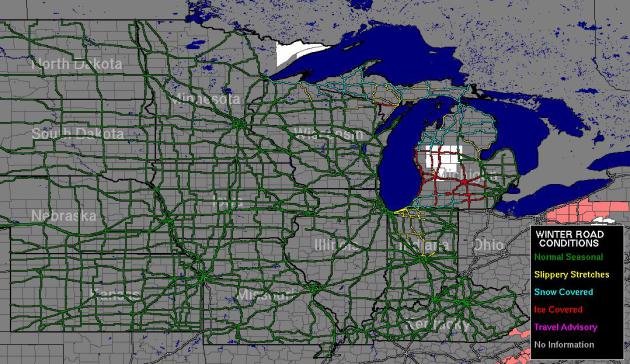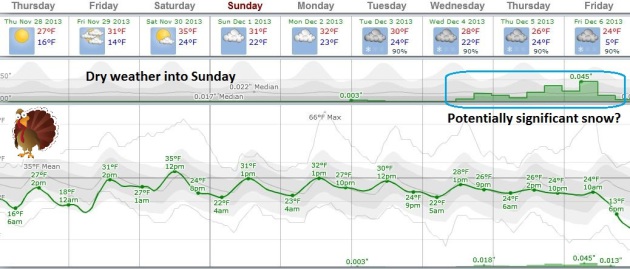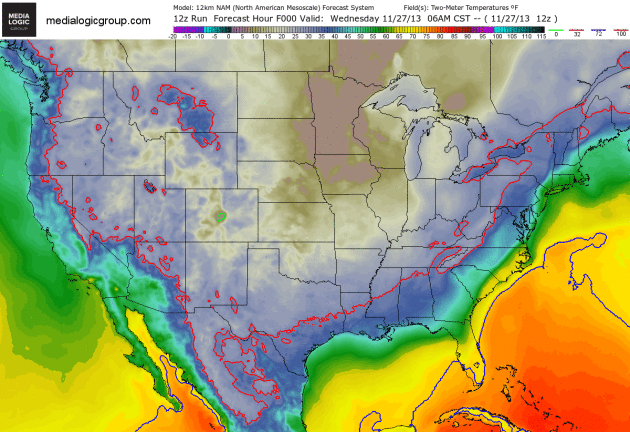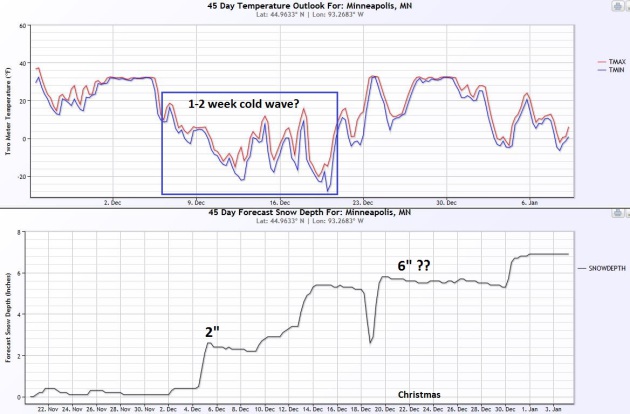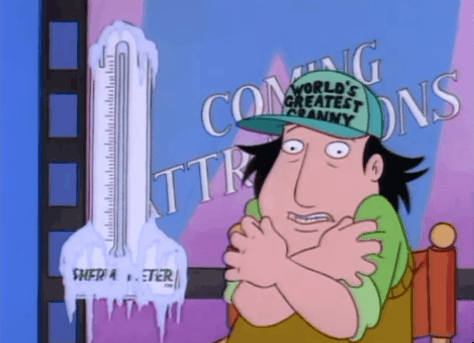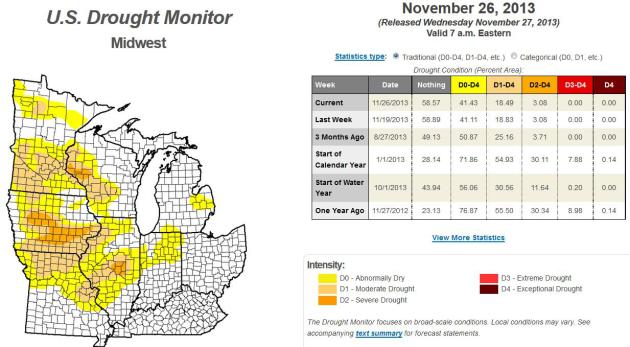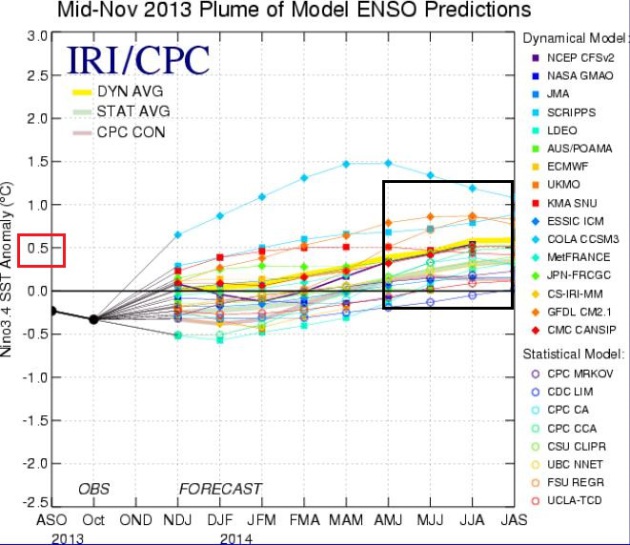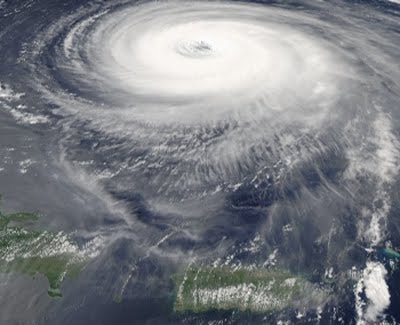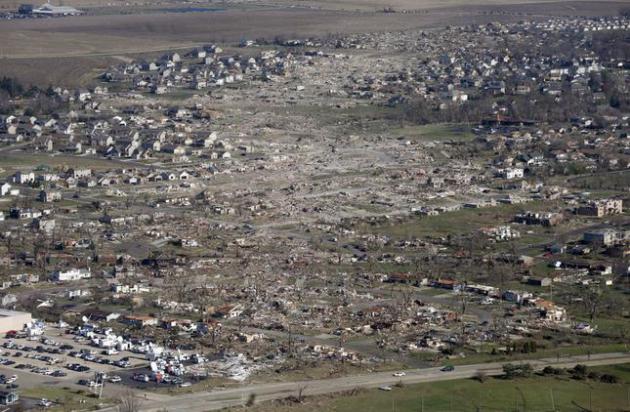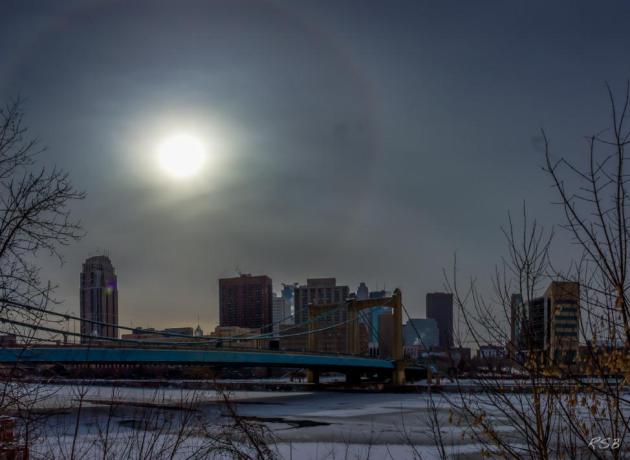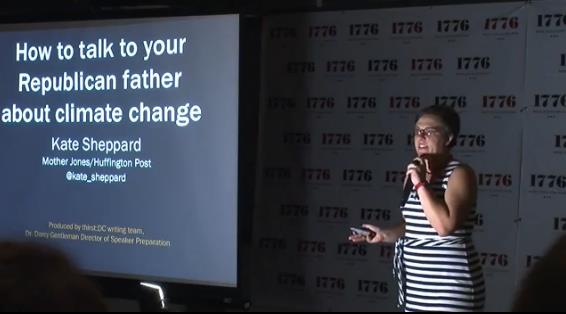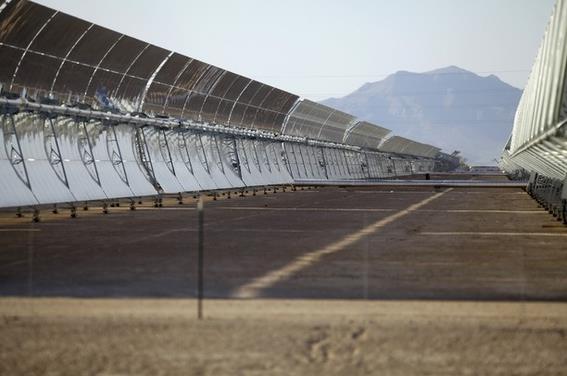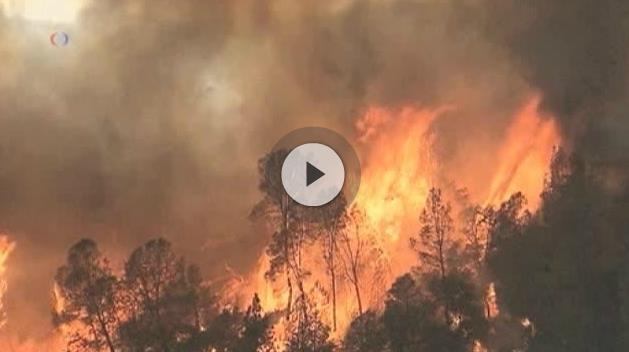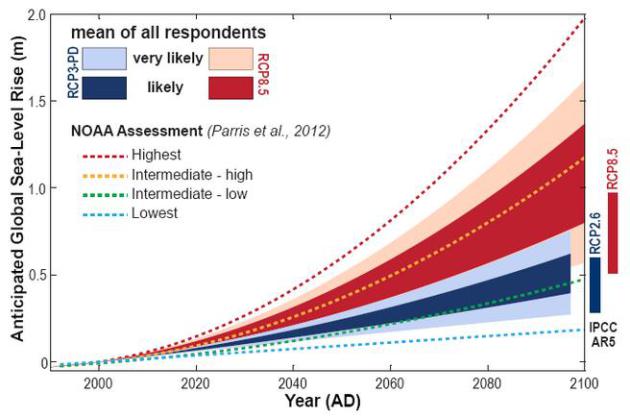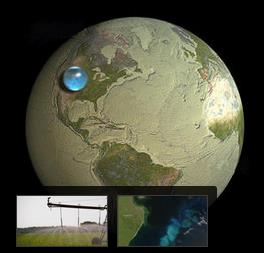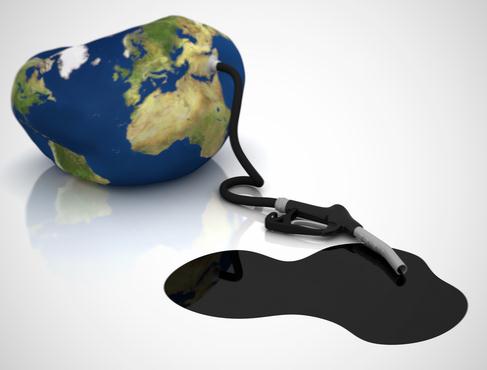 "Thanksgivukkah"
"Thanksgivukkah"
My
late mother taught us to celebrate Thanksgiving every day of the year.
She had a point. Our ancestors at Plymouth Rock were living meal to meal
- trying to avoid smallpox and being murdered by Old Man Winter. It
puts our modern-day challenges and setbacks into perspective.
Thanksgiving and Hanukkah fall on the same day for the first time since 1888. It won't happen again until 78,881. No kidding.
The
hyper-local dining room forecast calls for several inches of turkey and
blizzards of mashed potato drifts, washed down with a few showers of
hot gravy.
Am I stuffing too much into this forecast? My bad.
It's
chilly, but at least the sun is out, afternoon highs in the mid-20s. No
problems for power-shopping Friday or getting home Sunday. ECMWF model
guidance shows a potential for a significant, plowable snowfall from
Wednesday night into Friday of next week, followed by a healthy swipe of
arctic air in 8-12 days; even a few nights below zero in the metro
area?
NOAA's CFS (Climate Forecast System) model predicts 5 inches
of snow on the ground for Christmas. We'll see. Statistically 7 out of
10 Christmases at MSP are white.
OK, enough babble. Time for my pre-turkey nap.
Macy's Might Have To Throw A Thanksgiving Day Parade Without Balloons. It's all about wind speeds and gusts in mid-town Manhattan; details in this clip from
The Wire: "
After
a 1997 balloon crash on a windy parade day left one woman seriously
injured, the city enacted a rule barring balloons from the parade if
sustained winds reach 23 mph and gusts exceed 34 mph.
Current forecasts predict sustained winds of 20 mph and gusts of 36
mph. Macy's spokesman Orlando Veras told the AP that
parade officials won't make a decision on the balloons until tomorrow
morning: "On Thanksgiving morning, Macy's works closely with the NYPD,
who, based on real time weather data and the official regulations,
determine if the balloons will fly and at what heights," he said..." (Photo credit above: AP).
Your Thanksgiving Turkey In 6 Eye-Popping Charts. I did not know that! And frankly, I'm not sure I wanted to know that! The folks at
Mother Jones break down turkey consumption and a few head-shaking nuggets.
"Thanksgivukkah". Today is an extraordinary day in many respects, as pointed out in this amusing
YouTube video clip: "
The
last time Thanksgiving and Chanukah converged, it was 1888. It won't
happen again until the year 78811 (and that's CE!). To celebrate, we
wrote a song. Happy Thanksgivukkah, everyone!"
Midwest Travel Conditions.
Roads are snow and ice covered across much of Michigan and northern
Indiana, the result of lake effect snow squalls. Click here for the
latest road conditions, courtesy of the
University of Wisconsin.
Quiet Into Sunday - Major Pattern Shift Late Next Week?
It's too early to start ringing the snow bell (gong), but I'm seeing
some signs on the maps that winter may finally bully its way into
Minnesota and the rest of the USA late next week, preceded by the best
chance of accumulating snow I've seen yet this winter season, from late
Wednesday into Friday of next week - before temperature go over a cliff.
The good news: no weather-related travel drama close to home into
Monday. Graph: Weatherspark.
Thanksgiving Chill.
Temperature will run a few degrees below average today from the Upper
Mississippi Valley into the Great Lakes and New England, cold exhaust on
the backside of the coastal storm that soaked much of the eastern
seaboard. Watch the 32-degree isotherm (solid red line) push into the
Florida Panhandle. Animation: NOAA and Ham Weather.
Think Snow.
Anyone who follows the weather closely will take one look at the
predicted 500 mb map above and see the (growing) potential for a
significant snow event in early December from the Rockies into the
Plains and Upper Midwest. Details are sketchy, but a surge of bitter air
is forecast to carve out a deep long-wave trough over the Rockies,
turning steering winds to the southwest, allowing Gulf moisture to surge
north. These troughs of low pressure are storm incubators, and this
could spell significant snow from Denver to Omaha and the Twin Cities
the latter half of next week.
45-Day Wish-Cast.
NOAA's CFS (Climate Forecast System) model is suggesting an extended
period of temperatures well below average, from roughly December 6-18; a
couple of weeks of single digits and teens for highs and nights below
zero? We'll see, but this model has been fairly consistent with bitter
air for the second week of December. By the way, we're scheduled to have
nearly 6" of snow on the ground for Christmas in the Twin Cities. Give
or take 6 inches. Source: NOAA CPC and Ham Weather.
Everything You Know About Getting Warm Is Wrong.
Huffington Post
has a timely article about methods for staying warm in the coming
months; what works, and what just makes the situation even worse. Here's
an excerpt: "...
Drinking alcohol lowers your core body temperature, increases your risk for hypothermia and prevents your body from naturally shivering to keep warm.
The reason why you feel warm while drinking alcohol is that your blood
vessels dilate and send warm blood away from your core and towards your
skin. This effect is only temporary and in the end significantly
decreases your body's ability to fight the cold..."
In Spite Of Nagging Drought - 2013 Was Second Best Year For Farming Since 1973. Here's an excerpt of a good summary from
CNBC: "...
In
crop projectiongs this month, the USDA increased its estimated total
for corn to 1 percent over last year's estimate, and soybean production
up 3 percent from the 2013 estimate. Corn will see total production at a
record level of nearly 14 billion bushels. Those higher estimates came
despite many areas of Iowa, Minnesota and the Upper Midwest dealing with
late planting, along with some late-season drought conditions. Net farm
income is also on the rise. It's forecast to be $120.6 billion in 2013,
up 6 percent from 2012's estimate of $113.8 billion. After adjusting
for inflation, 2013's net farm income is expected to be the second highest since 1973, according to the USDA..."
* the latest U.S. Drought Monitor update for the Upper Midwest, Great Lakes and Ohio Valley is
here.
Growing Signs Of El Nino In 2014. The graphic above is from NOAA's latest
ENSO update;
after years of a perpetual La Nina cooling phase of the equatorial
Pacific there are growing signs of a possible El Nino warming phase
developing by early 2014; which may, in turn, favor milder than normal
temperatures, and a southern storm track across the USA into the latter
half of winter. It won't be declared an official El Nino event until and
unless we go at least 3 consecutive months with sea surface
temperatures .5C warmer than average.
Battling Flames In Forests, With Prison As The Firehouse.
The New York Times has the story of how many states are throwing more manpower on the front lines of major wildfires; here's an excerpt: "...
As
federal agencies have cut costs during the budget standoffs in
Washington, further decreasing the size of a firefighting work force
that has already been reduced by 40 percent since the 1980s, the burden
of fighting wildfires has been shifted to states and local
jurisdictions, even as they struggle under the weight of a sluggish
economy. Prison crews, cheap and dependable, have emerged as a solution
as wildfires burn bigger, hotter and longer each year and take up a
growing portion of the United States Forest Service budget. (In 2012
alone, federal agencies spent $1.9 billion on wildfire suppression, just
shy of the record, set in 2006.)..." (Photo above: Grand Junction office of the National Weather Service).
Least Active Atlantic Hurricane Season In 30 Years. Meteorologist Andrew Freedman has a good summary of a head-scratcher of a hurricane season at
Climate Central; here's an excerpt: "
Defying dire outlooks
issued in the spring, the 2013 Atlantic hurricane season, which
officially ends Nov. 30, was the least active since 1982, and the
sixth-least-active season since 1950, the National Oceanic and
Atmospheric Administration (NOAA) said on Monday. There were no
landfalling hurricanes in the U.S. in 2013. In fact, it has been more
than 8 years since the last major hurricane of Category 3 intensity or
greater struck the U.S., a record stretch. The last major hurricane
strike occurred in 2005, when Hurricane Wilma hit Florida. When the
start of the 2014 Atlantic hurricane season rolls around on June 1,
2014, it will have been 3,142 days since that storm made landfall, a
record timespan..."
Graphic credit above: "
Map of 2013 tropical storm and hurricane tracks." Credit: Wikimedia Commons.
The Pioneers Of Seasonal Hurricane Forecasting Might Stop Doing It. They insist it has nothing to do with this year's poor track record, as reported by SFGate.com; here's a clip: "...Many
seasonal forecasters predicted that overall activity — measured in
terms of the number of storms, their intensity and their duration, would
be as much as twice as high as average levels. Instead activity was
only about 30 percent of typical levels, or one of the five quietest
years in the last half century of Atlantic hurricane seasons. Now comes
word that the dean of seasonal forecasting, William Gray and his
co-author Phil Klotzbach, of Colorado State University, may be ending
their forecasts. It has nothing to do with their poor forecast this
year, they say..." (Image credit: NASA).
Before And After The Tornadoes In Illinois. ESRI
has an interactive URL that shows the severity of damage in Washington
Illinois, after an EF-4 tornado bull-dozed its way across the center of
town on November 17.
The Silent Triumph: Weather Warnings Saved Hundreds Of Lives In Midwest Tornado Outbreak.
106 tornado reports on November 17, some as far north as Michigan -
unprecedented in their violence and how late in the season they formed
this far north. Here's a clip from
Capital Weather Gang, a quote from meteorologist Mike Smith that resonated: "...
The
lower death toll from this week’s storms was not inevitable; it is the
result of a half-century of scientific discovery and technological
development: Doppler radar, weather satellites, lightning detection
networks and smartphone apps. It is a result of volunteer storm chasers
instantly reporting the most violent tornado (the Washington, Ill.,
storm) when it first touched down near Pekin.
No other nation
enjoys the quality and breadth of meteorological services available in
the United States. It is an area in which federal dollars are put to
valuable use and leveraged through the efforts of private-sector weather
companies such as AccuWeather, and by meteorologists and emergency
managers.
File photo above: AP Photo/Charles Rex Arbogast.
Special Report: Storming The Field.
Fans sitting in a stadium are sitting ducks when it comes to weather,
especially extreme weather. New technologies, apps and alerts can help,
but it pays to be continually weather-aware. Don't depend on anyone else
for your safety, or the safety of your family. Here's an excerpt of a
story at
WTVM.com in Columbus, Georgia: "...
It
could be dangerous, but where are you supposed to go?" asked former
Auburn kicker Al Del Greco. Tornadoes can happen anywhere, even at
football stadiums. The good news is that tornado safety has changed
since 1983. Just this season, the South Carolina/North Carolina game was
delayed and the stadium was evacuated after a severe storm with
lightning moved in during the second half. Colleges and universities now
have rules in place, and it starts with the suspension of play. "If we
left the game playing, nobody's going to leave. They're not going to
take it serious. They're going to sit there and keep watching as long as
it's playing," explains Chance Corbett, the Auburn director of public
safety..."
Stock Returns Affected By Weather, Says Study. Say what?
Valuewalk.com has a story that made me do a triple-take; here's an excerpt: "
The Quant Research Team at www.empiritrage.com has drawn attention to a recent study
by William Goetzmann, Dasol Kim, Alok Kumar and Qin Wang which shows
that weather-based indicators of mood impact perceptions of mispricing
and trading decisions of institutional investors. According to
Empiritrage analyst William N. Goetzmann, “It is interesting because it
points out that weather may affect highly educated investors, and that
it would be interesting to see how the temperature (as opposed to
cloudiness) affects stock returns...”
Researchers Track Outdoor Air Temperatures By Measuring The Battery Temperatures Of Smartphones. Here's an innovative way to track hyper-local changes in air temperature, as described in this clip from
Inside Science: "...
On
the other hand, Georgescu's ASU colleague David Hondula, who was not
involved in this study, wants to use smartphones to track the heat
exposure of individuals. "If your phone is tracking your weather
conditions, you might have a personalized alert that you have
experienced excessive heat as you've moved through your daily life,"
said Hondula. When informed of their heat exposure, people can take
steps to protect their health, and thus reduce heat-related mortality.
In Hondula's words, "There's certainly the potential for many important
questions to be answered, if everyone's walking around with a potential
environmental monitor in their pocket."
The Daniel Fast: A Diet From God? Step away from the turkey - just fruit and vegetables going forward, ok? Here's a clip from an interesting story at
The Atlantic: "...
Daniel
said he and his friends would eat a diet of only vegetables (“pulse”).
After 10 days, they grew healthier and stronger than the Babylonians,
and his diet became a small demonstration of his opposition to the
King’s power. This passage is occasionally used to encourage Christians to resist the corrupting influences
of the outside world. But several years ago, some Protestant churches
began to take the “diet” aspect of Daniel’s story literally. Motivated
by both faith and fitness, today many protestant Christians around the
country are, like Daniel, occasionally limiting themselves to fruits and
vegetables for 21-day increments..."
Image credit above: "
flickr/A Gude/Waiting for the Word/Frapestaartje."
"Action": From Sports Star To TV Star. The New Yorker
has a fascinating article about how ESPN grooms it's on-air talent,
making that hard turn from sports star to TV "personality"; here's the
excerpt: "...
ESPN, the Megalodon of sports broadcasting, has no
shortage of retired millionaires sending job applications: both the
N.F.L. and the N.B.A. host annual seminars for players interested in
broadcasting, and a current Pittsburgh Steeler recently asked if he
could work as an unpaid intern. But finding linebackers who understand
the difference between B-roll and a boom mike can be difficult. “They go
from a job where you’re trained to say as little as possible to a job
where you need to say as much as possible,” Gerry Matalon, a senior
producer who helps run ESPN’s on-air talent development, said recently.
In 2008, to remedy the problem, ESPN created a talent department staffed
with several performance coaches like Nash..."
* 22 degree halo photo courtesy of Steve Burns.
Climate Stories...
Can You Talk Turkey With Your Climate-Change-Denying Relatives This Thanksgiving? After reading this (and checking out the video) I wasn't sure whether to laugh or weep; here's an excerpt from
Huffington Post: "...
Thanksgiving
is coming and you know what that means, folks: dinner with your
climate-change-denying relatives. You know who I'm talking about. The
uncle who thinks sunspots are the reason the planet's getting warmer.
The cousin who thinks dinosaur farts are to blame. Grandma, who also
thinks President Barack Obama is a lizard from space.
Maybe you try to avoid these conversations at your Thanksgiving dinner.
But there usually comes a point in the evening when, having exhausted
all conversation about how lovely the new trivet is and yes, the traffic
yesterday was just the worst, other topics come up. Sometimes you start
talking about the weather … and then all of a sudden you're arguing
about whether Al Gore's breath is really the reason it's been so hot
lately..."
Chris Hadfield: We Should Treat Earth As Kindly As We Treat Spacecraft. Here's an excerpt of a thoughtful, timely piece from NASA astronaut Chris Hadfield, in
Wired Science: "...
While
I was on the space station, I used Twitter to ask hundreds of thousands
of people what they would like me to take a picture of. Resoundingly,
the answer was “home.” Everyone, from all around the world, wanted to
see their hometowns. I found that thought-provoking. After millennia of
wandering and settling, we are still most curious about how we fit in
and how our community looks in the context of the rest of the world. A
curiosity of self-awareness, now answerable by technology. This is
where the answers to our problems will start..."
Image credit above: "
Astronaut Chris Hadfield was commander of Expedition 35 on the International Space Station, from December 2012 to May 2013." Tavis Coburn.
Solar Energy Was America's Sole New Power Source In October.
My dream (among others) is to be able to power my Tesla Model S, for
free, with affordable solar power and battery storage in my garage. That
day may be fast approaching. Here's a clip from
The Atlantic: "
In October, power plants generating 530 megawatts of electricity came online in the United States. And every single electron put on the grid came from the sun,
according to a report released today. It’s possible to make too much of
the fact that solar energy was the sole source of new electricity
capacity in US that month. After all, the completion dates of power
plants can be random. That’s particularly true for complex,
multibillion-dollar, fossil fuel power stations that can take years to
build and are subject to oversight by state regulators..."
Photo credit above: "
A solar thermal power plant." (Reuters).
High Intensity "Megafires" A New Global Danger. Here's an excerpt (and video clip) from VOA,
Voice of America: "
The
term “megafire” was coined about a dozen years ago in the United States
in light of the fact that only 1-2 percent of all wildfires had come to
account for more than 85 percent of costs and burned area. Similar
trends are happening elsewhere. "In the western United States, we have
larger fires occurring over a longer period of time. The fire season -
what we have to deal with - is really changing," said Bill Kaage,
Wildland Fire Operations Director for the U.S. Park Service at the
National Interagency Fire Center (NIFC) in Boise, Idaho. The numbers are
startling. According to the NIFC, 82,591 wildfires in the U.S. burned
nearly 1.2 million hectares in 1985. Yet it took only 67,774 fires to
consume more than 3.7 million hectares in 2012 - more than a threefold
increase..."
How High Will Sea Levels Rise? Let's Ask The Experts. Here's a snippet from a comprehensive article at
The Washington Post: "...
So here's one way to get a better sense for the broader debate: A new study
in Quaternary Science Reviews simply asked 90 experts on sea-level rise
for their projections, based on their work. This isn't brand-new
scientific research, but it does give a very useful overview of the
current state of research. The results? The experts, on average, think
global sea levels will rise somewhere between 0.7 and 1.2 meters by the
end of the century if global warming continues unchecked (that's between
2.2 and 4 feet)..."
Acidifying Oceans Alarm Hundreds Of Scientists. Here's a clip from a story at
Environment News Service: "...
Climate
change is causing the world’s oceans to acidify at rates not seen for
the last 55 million years, and the only way to moderate this danger is
to reduce human emissions of carbon dioxide, conclude 540 scientists
from 37 countries in a new report. Their conclusion is the outcome of
the Third Symposium on the Ocean in a High CO2 World that took place in
Monterey, California in September 2012. The findings of these experts
were presented in a report to the Conference on Climate Change that took
place in Warsaw from November 11 to 22..." (Photo credit: Alamy).
Research Suggests Future Global Warming Has Been Underestimated.
UPI has the article - here's a clip: "
Global
warming could go on for centuries even with a complete stop of CO2
emissions and then stabilize at an even higher temperature, a Swiss
scientist says. Researcher Thomas Frolicher says computer models
contradict the assumption by many scientists that global warming would
come to an end if, some day, humans succeed in ending the release of
greenhouse gas emissions into the atmosphere. Frolicher and U.S.
colleagues report they've used a model that represents physical and
biogeochemical processes -- such as the exchange of greenhouse gases and
heat with the oceans -- at a far more detailed level than many previous
models..."
What 11 Billion People Mean For Water Scarcity.
Yahoo News has the story - here's the introduction: "
The
water woes plaguing the Southwest foreshadow a worldwide problem to
come. Already, 2.7 billion people globally face at least some water scarcity,
according to a 2012 study detailed in the journal PLOS ONE. Fights over
water rights are causing political conflicts and instability in such
places as the Nile valley and the Indian subcontinent. As population
sizes rise, those conflicts will get more intense, according to a report
by the National Intelligence Council, which advises the director of
national intelligence for the United States about national security
issues. And the latest population models predict that 11 billion people will live on Earth by 2100, according to a United Nations report released last summer..."
On Campuses, A Fossil Fuels Divestment Movement.
The Washington Post has the story - here's the introduction: "
A
divestment movement is marching across U.S. college campuses, borrowing
tactics from the 1980s anti-apartheid campaign and using them against
oil, gas and coal companies to fight climate change. Students are
teaming with investment advisers to convince universities, pension funds
and institutional investors that they can take a stand against
fossil-fuel companies without hurting their returns. “We have a
government that has been taken over by the fossil-fuel industry, so
we’re going to pressure the fossil-fuel industry itself,” said Chloe
Maxmin, a junior leading Divest Harvard..." (Image: Clean Technica).
Global Warming Threatens Pacific Economies, Report Says. Here's an excerpt from Real Time Economics at
The Wall Street Journal: "...
Rising
temperatures might sound nice for people planning a beach vacation. But
for Pacific Island nations, global warming poses a big threat to their
ability to capture tourist dollars, according to the Asian Development
Bank. In a report Tuesday,
the Manila-based lender says sun-baked tropical nations from Samoa to
the Cook Islands that rely on tourism income could become less
attractive destinations as global temperatures rise..."
Photo credit above: Reuters. "
A wall built to protect people from rising tides in the Pacific island nation of Kiribati."
U.S. Methane Study Says Emissions 50% Higher Than EPA Estimates. Here's an excerpt from a story by the AP and
Huffington Post: "
The
United States is spewing 50 percent more methane — a potent
heat-trapping gas — than the federal government estimates, a new
comprehensive scientific study says. Much of it is coming from just
three states: Texas, Oklahoma and Kansas. That means methane may be a
bigger global warming issue than thought, scientists say. Methane is 21
times more potent at trapping heat than carbon dioxide, the most
abundant global warming gas, although it doesn't stay in the air as
long. Much of that extra methane, also called natural gas, seems to be
coming from livestock, including manure, belches, and flatulence, as
well as leaks from refining and drilling for oil and gas, the study
says. It was published Monday in the Proceedings of the National Academy
of Science..."




